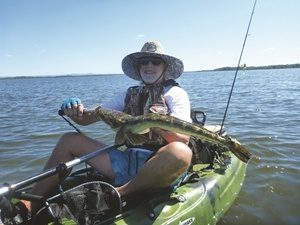




AFTER receiving a call from my folks that they were coming to stay and fish on the weekend, I checked the water conditions and as expected it resembled coffee. We received considerable rainfall down the east coast of Australia recently and this could mean that anglers would be faced with dirty water for a few weeks. All is not lost though if we take these conditions into consideration when planning our fishing trips. Fishing after rain
Clean water and colour changes
Taking the time to find the clean water and colour changes in a system can increase catch rates and many anglers will head to river mouths and entries to estuaries in search of a fresh tidal push. This cleaner water will often carry bait and increased salinity, in turn firing up the predators. Paying close attention to current lines and channels may also identify colour lines and colour changes, with many predators using these colour changes as cover when ambushing prey.Fishing after rain
Weed equals feed
Unfortunately, where my parents and I were fishing, the entire system was brown, so we had to come up with another plan. There’s an old saying ‘find the bait, find the fish’ and in times of an influx of fresh, I have often had success fishing around the weed beds – believing that the weed holds the salinity and in turn attracts bait. Our plan was to make the most of a big run-in tide, hopefully bringing with it cleaner water and bait, to move up onto a big weed flat and fish the pockets in the weed, broken rubbly bottom and mangrove edges.Fishing after rain
Lure model and colour
Another key consideration when fishing in dirty water is ensuring your lures are seen and felt by the fish, so we selected paddle tail plastics with plenty of action and vibration. When it comes to colour selection, the theory in dirty water is to select a darker, contrasting colour that offers a better silhouette in the water, while also considering an ultraviolet reactive plastic to make the most of any available UV light penetrating into the water.
Taste and smell
You can also help the fish find your lure by scenting up. Fish have nostrils and when the water filters in and out, they pick up on scents in the water. Fish also have taste buds, with several species even having taste buds on their heads or whiskers. Adding scent offers both a realistic taste and smell to predatory species that are hunting in dirty water – attracting fish and triggering strikes.Fishing after rain
Fish on
With this information in mind, we tied on our darker UV reactive plastics, scented up and headed for the weed flats on a run-in tide. It didn’t take long to locate areas where the bait was concentrated, making note of prawns flicking or baitfish being hassled. My folks were soon hooked up, with bream and grunter nailing the little Z-Man 2.5” Slim SwimZ rolled over the top of the weed and hopped through sand patches. The push of the incoming tide wasn’t enough to clear the water, but it definitely saw an increase in bait and fish activity, with a few trevally spotted busting up around us.Fishing after rain
A screaming drag quickly indicated that my mum had managed to pin one of these powerful speedsters, and it was cool to watch the battle – the spinning kayak and the screaming before I netted the fish for her. A great little fish for the estuary and a big smile from the angler. When the bite began to slow a little, we moved in tight to the mangroves and my parents managed a flathead each.
Here I opted to rig a Z-Man 3” Baby Goat weedless on a 1/6oz size 1 TT Lures SnakelockZ Finesse jig head. Weedless rigging is another option when the water is dirty, as it allows you to more effectively fish weed and other structure with minimal chance of snagging or fouling. This allowed me to slow things down, fish in among the weed that was holding the bait and land a few flathead, including one around the mid-60cm mark.
Though it hadn’t been the hottest bite on record, over a couple of short sessions we had managed to land a mix of bream, grunter, trevally and flathead by taking note of and fishing to the less than ideal conditions. Hopefully there’s a few things that you can keep in mind when fishing dirty water, including how, when and where you’re fishing, along with what you’re presenting to the target species. The next challenge facing anglers will be the crystal-clear water conditions of winter… but that’s another challenge and another article.Fishing after rain
Fish on and see you on the water…
 Bush ‘n Beach Fishing Magazine Location reports & tips for fishing, boating, camping, kayaking, 4WDing in Queensland and Northern NSW
Bush ‘n Beach Fishing Magazine Location reports & tips for fishing, boating, camping, kayaking, 4WDing in Queensland and Northern NSW









